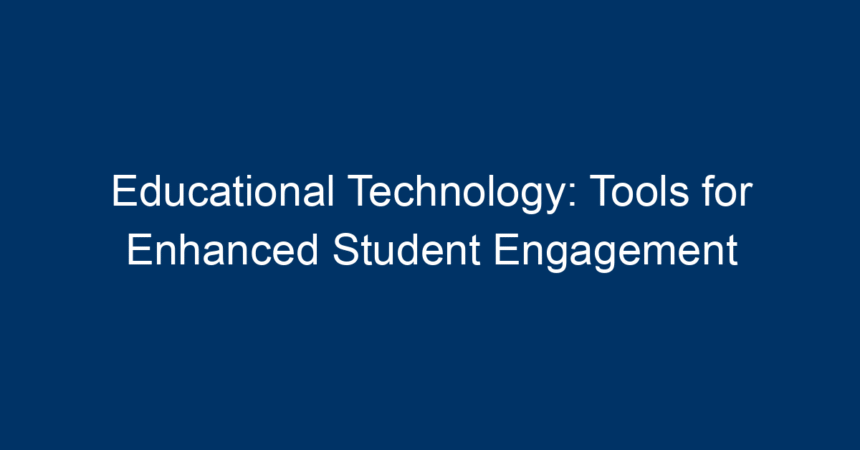Introduction
In the rapidly evolving landscape of education, educational technology has emerged as a game-changer. From virtual classrooms to interactive software, these tools provide innovative ways to enhance student engagement. As educators seek to captivate and inspire learners, embracing these technologies becomes essential. In this article, we will explore various educational technology tools that can transform traditional learning environments, making them more interactive and effective.
Understanding Educational Technology
What is Educational Technology?
Educational technology refers to the integrated use of technology within educational practices to facilitate teaching and learning. This encompasses a wide range of tools, applications, and methods aimed at enhancing educational experiences.
Importance of Educational Technology in Student Engagement
The role of educational technology has never been more significant. With students often accustomed to interactive digital engagement in their daily lives, integrating technology in educational settings is crucial. Not only does it enhance retention rates, but it also promotes a collaborative learning environment where students feel more connected to the subject matter.
Tools for Enhanced Student Engagement
1. Learning Management Systems (LMS)
Learning Management Systems like Moodle and Canvas are essential tools in modern education. They provide a centralized platform where educators can upload resources, create assignments, and foster communication between students and teachers.
Benefits of LMS:
- Accessibility: Students can access materials anytime, anywhere, fostering independent learning.
- Tracking Progress: Educators can monitor student performance and tailor instruction accordingly.
- Interactive Features: Many LMS platforms incorporate quizzes and forums to boost engagement.
2. Gamification Tools
Gamification is revolutionizing student engagement through interactive and motivational elements in education. Tools like Kahoot! and Quizizz allow educators to create engaging quizzes that encourage friendly competition.
Why Gamification Works:
- Increased Motivation: The competitive elements make learning fun and engaging.
- Instant Feedback: Students receive immediate results, enabling them to identify strengths and weaknesses.
- Collaboration and Social Learning: Gamified platforms encourage teamwork and discussion among peers.
3. Online Collaboration Tools
Collaboration is key in harnessing the full potential of student engagement. Tools like Google Workspace and Microsoft Teams enable students to work together on projects, regardless of their location.
Key Features:
- Real-Time Editing: Students can collaborate simultaneously, enhancing teamwork skills.
- Resource Sharing: Easy sharing of documents promotes a more inclusive learning experience.
- Discussion and Feedback: Integrated chat functions allow for continuous communication and feedback.
4. Interactive Multimedia
Incorporating multimedia elements such as videos, podcasts, and interactive simulations can significantly improve engagement. Platforms like Edpuzzle and Nearpod allow educators to embed questions within videos or create interactive lessons.
Advantages of Multimedia:
- Visual Learning: Catering to different learning styles helps accommodate all students.
- Engagement Through Interactivity: Active participation in lessons keeps students attentive.
- Real-World Applications: Simulations provide hands-on experiences that make theoretical concepts more tangible.
5. Virtual and Augmented Reality
Emerging technologies like virtual reality (VR) and augmented reality (AR) offer immersive learning experiences. Tools such as Google Expeditions and ClassVR can transport students to places far beyond their classrooms.
Impact on Learning:
- Enhanced Engagement: Immersion fosters a deeper connection to the material.
- Experiential Learning: Students can explore complex concepts visually and interactively.
- Inclusivity: These technologies can cater to varied learning preferences, benefiting all students.
6. Social Learning Platforms
Social learning platforms like Edmodo and Flipgrid provide spaces for students to connect and collaborate outside traditional classroom boundaries. These platforms allow for sharing ideas and resources, promoting an engaged learning community.
Benefits of Social Learning:
- Peer Interaction: Encourages discussion and knowledge-sharing among students.
- Student-Centered Learning: Empowers students to take charge of their learning paths.
- Continuous Learning: Students feel connected beyond lectures, leading to a more robust understanding of subjects.
Challenges in Implementing Educational Technology
While the benefits are significant, integrating educational technology can come with challenges:
1. Digital Divide
Not all students have access to the necessary technology or Internet connectivity. Efforts must be made to ensure equality in access.
2. Training and Support
Educators may need training to effectively integrate these technologies into their teaching strategies. Continuous support is essential for successful implementation.
3. Resistance to Change
Some educators and institutions may hesitate to embrace new technologies due to comfort with traditional methods. Overcoming this resistance requires demonstrating the value and effectiveness of these tools.
Actionable Insights for Educators
1. Evaluate Your Current Tools
Take time to understand the effectiveness of the tools you currently use. Are they enhancing engagement? Are students responding positively?
2. Pilot New Technologies
Before fully implementing any new educational technology, conduct pilot programs to assess their impact on student engagement and learning outcomes.
3. Foster an Inclusive Environment
Make sure all students have access to the necessary technologies. Consider alternative arrangements for those without reliable Internet or devices.
4. Encourage Student Feedback
Solicit feedback from students regarding the tools they find most engaging. Their insights can guide you in refining your approach to using technology.
5. Stay Updated on Trends
Educational technology is continually evolving. Stay informed about the latest tools and methods to ensure your teaching remains effective and relevant.
Conclusion
Educational technology has the potential to transform the way educators engage students. From gamification to virtual reality, numerous tools can reshape the learning experience, making it more interactive and impactful. However, successful implementation requires thoughtful consideration of challenges, training, and continuous adaptation. By incorporating these technologies, educators can not only enhance student engagement but also foster a lifelong love of learning. Embrace the tools, encourage collaboration, and witness the change in your classroom—making education a vibrant, engaging journey for every learner.




